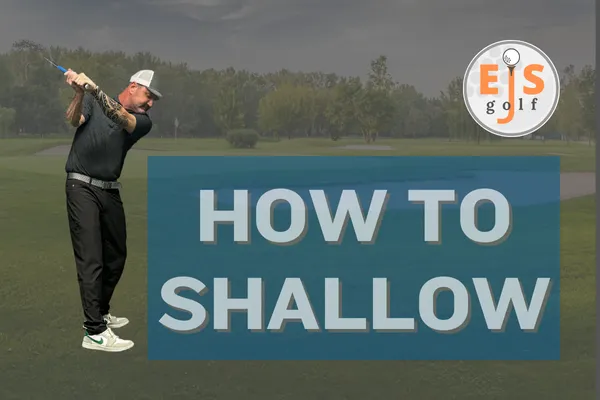EJS GOLF BLOG
Learn about the golf swing and what you can do to improve your score on the golf course. Fill out the form below if you have any questions or want to set up a time to talk.
Mastering the Art of Golf with Coach Erik Schjolberg
I’m Coach Erik Schjolberg, and welcome to the EJS Golf blog—Scottsdale’s authority on science-driven ball-striking. Here you’ll find in-depth analyses of swing mechanics, data-backed breakdowns of impact and launch dynamics, and actionable practice routines designed to rewire your muscle memory from day one. Each post peels back the curtain on cause-and-effect in your swing, whether you’re chasing Tour-level precision, collegiate consistency, or lower weekend scores. Dive into our deep-dive articles, master the drills that drive real improvement, and transform your game with proven science and strategy.
But let’s be clear: golf isn’t only about perfecting swing mechanics. The mental battle you fight on each tee is often the one that determines whether you stay in the game or walk off the course. Here, we’ll tackle the psychological hurdles—the pressure of a tight leaderboard, the frustration when a swing fails under stress, the self-doubt that creeps in after a bad hole. You’ll learn evidence-based mental strategies—visualization routines, pre-shot rituals, stress-management techniques—that fortify your focus and resilience. Mastering these mind-set tools is just as critical as dialing in your impact position, and I’ll show you exactly how to integrate mental training into your practice for lasting confidence on every shot.
Explore Our Blogs

Master How to Shallow for Distance and Precision
How to Shallow for Distance and Precision
Hi friends and golfers! I'm Coach Erik Schjolberg, owner of EJS Golf at McCormick Ranch Golf Club in Scottsdale, AZ. With over 25 years of experience coaching golfers from PGA Tour pros to passionate amateurs, I'm dedicated to helping every player improve from their very first lesson. My state-of-the-art facility and data-driven approach guarantee results, whether you're seeking in-person Scottsdale golf lessons or online golf lessons. Visit my website, EJS Golf, to learn more about the Science of Better Golf and let's elevate your game together!
Shallowing the golf club is a hallmark of elite players and Tour professionals. Shallowing places the golf club in an ideal slot during the downswing. For recreational golfers, this move can significantly lower their scores by improving their ability to hit the ball solidly while reducing common mishits like slices, chunks, weak pop-ups, thin shots, pulls, inconsistent contact, non optimal distance, pop-up drives and among other poor shots, the difficulty with long irons.
In this guide into the science of shallowing the club, I will debunk common misconceptions and give drills to help you gain this essential skill. By understanding and applying these principles, you’ll be well on your way to elevating your game and lowering your scores. Remember, 15 minutes per day, is all you need to achieve big goals! So, please don't feel overwhelmed. Focus on the process of change, not the result.
Shallowing the club refers to the action of bringing the golf club down on a flatter plane during the downswing, relative to the angle established during the backswing. This motion allows the club to approach the ball from the inside, promoting better contact and increased club head speed. It also contributes to a more controlled ball flight, helping you to hit straighter and more consistent shots.
At the core of shallowing the club is the relationship between the club’s center of mass and the forces applied by the golfer. When you begin the downswing, the forces exerted on the handle influence the club’s motion. If these forces are applied correctly, the center of mass moves in a way that naturally shallows the club, allowing for a more efficient swing path.
A critical concept in understanding shallowing is the term moment arm, which is the perpendicular distance between the line of force applied to the handle and the center of mass of the club. A larger moment arm creates a greater potential for torque, influencing the club to shallow. Think of moment arm is if you are using a wrench. If the wrench has a 3 inch handle and the bolt is tight, it would be hard to move it possibly. But if the wrench had a 12 inch length, the user would have a much better chance to apply much more force to move the bolt. By optimizing the moment arm, you can generate more power in your golf swing leading to greater ball speed.
Golf is a game of match-ups! As a golf coach I am always looking for what goes with what and what changing one part of the golf swing will do to some other part and ultimately what does that do to the golf ball. If what a golf coach is doing isn't affecting ball flight, in the end, what are you working on? Typically, what is being worked on is looking good for the camera. Any change that I am making in a golf swing better correlate to a change in the trackman number I want to change which ultimately ends up in the ball flight both the student and I want.
I learned one of the best lessons about golf from my father when I was young and upset about a good score on the golf course that day. He told me that there aren't any pictures or videos on the scorecard, only what you shot on that given day! That was profound to me b/c while shooting that good score I didn't feel like I had my "A" swing. I learned to find a lot of pride in shooting the best score I could when I didn't have my best. There is a lot to be proud of overcoming those feelings of being uncomfortable, not sure how to pull the trigger to start the golf swing, feeling like you have no idea where the ball is going to travel, etc.
Many golfers believe that shallowing the club is achieved primarily through wrist flexion or by consciously manipulating the wrists. While wrist action plays a role, overemphasis on this aspect can lead to timing issues and inconsistency. Relying solely on wrist movements can disrupt the natural flow of your swing and cause you to lose power. At first you may need to focus on this feel to internalize it through block practice.
Another common belief is that externally rotating the trail shoulder is the key to shallowing. While shoulder rotation contributes to overall swing mechanics, depending solely on this movement can create tension. This tension may limit your range of motion and prevent you from achieving the desired shallowing effect. Some golfers physically can not externally rotate their shoulder like they are being asked to do. Don't worry if this is you, you will be fiine.
Some instructors emphasize pronation of the forearm as the primary method for shallowing the club. Although forearm movement is involved, focusing too much on this can cause you to stop thinking big picture with your body as a unit and how changing one movement will affect something else. A holistic approach that is focused on the entire body’s movement is going to achieve better results and is inline with how I coach golf.
The golf club experiences forces and torques around three primary axes during the swing. These axes are often referred to as Alpha, Beta, and Gamma. By applying forces in the correct direction and magnitude, you can influence the club’s motion without resorting to unnatural manipulations. Specifically, applying an outward force on the handle during the downswing encourages the club to shallow naturally due to the moment arm effect. This approach allows the club to find the optimal path with less effort and reduces the need for conscious adjustments.
The effectiveness of these forces and torques depends on their timing and magnitude. Applying them too early or too late in the swing can lead to undesirable results, such as slicing or hooking the ball. Understanding when and how much force to apply is essential for mastering the shallowing technique.
It's important to note that while these torques are fundamental to the physics of the golf swing, they're just part of the equation. Factors like centripetal force, the golfer's body rotation, and the timing of force application all play crucial roles in creating an effective golf swing
Why Shallowing the Club Matters
Shallowing allows for an efficient transfer of energy from your body to the club head. By maximizing the angular impulse—the change in angular momentum—you can achieve higher club head speeds without extra effort. This increased speed translates to longer shots and can give you a significant advantage on the course. The closer you are to the hole off the tee, the lower your score will be.
Approaching the ball on a shallower plane removes the over-the-top swings that result in slices or pulls. A shallower approach promotes better contact and a better ball flight. This consistency can lead to lower scores which as we all know, can lead to a more enjoyable golfing experience.
A shallow club position enables you to rotate more effectively through the shot. This rotation not only contributes to power but also is what is supporting the greater swing speed, shaft lean, lack of early extension and morel. By rotating efficiently, you reduce the strain on your body and minimize the risk of injury. This is one of the top reasons golfers come to see me, rotation. Golfers want to understand rotation and it is deeper than just spinning your hips which is what most amateurs do instead of harnessing this power correctly.
Shallowing Drills
1. The Split-Hand Drill
• Grip the club with your lead hand at the top of the handle and your trail hand lower down, leaving a gap between the hands.
• Take slow practice swings, focusing on bringing the club down on a flatter plane.
• Feel how the separation forces you to use your body and arms correctly, promoting a natural shallowing effect.
2. The Wall Drill
• Stand with your back facing a wall, about a foot away.
• Practice your backswing without hitting the wall to ensure proper swing path.
• On the downswing, focus on shallowing the club by letting your club head attach to the wall as you feel the golf club lower about 6 inches to a foot.
3. Hell Drill
• Stand with your feet together to start.
• Remove your trail thumb and index finger from the golf club so that they are appying no pressure to the golf club
• On the downswing, swinging at 25-50%, keep those fingers off and continue through to a cut off follow through as in a punch shot.
Conclusion
Shallowing the golf club is a fundamental technique that can elevate your game to new heights. By understanding the science behind it and practicing targeted drills, you can unlock greater power, precision, and consistency in your shots. This mastery not only enhances your performance but also increases your enjoyment of the game.
Remember, effective shallowing isn’t about forcing unnatural movements but about applying forces strategically to let the club respond naturally. Incorporate these insights and drills into your practice routine, and you’ll be well on your way to mastering the art of shallowing. As you progress, you’ll notice improvements not just in distance but also in accuracy and confidence on the course.
Ready to take your game to the next level? Contact us at SwingYard.com for personalized coaching, and let us help you achieve your golfing goals. Our team is dedicated to providing you with the tools and knowledge you need to excel.
Q&A: Addressing Common Questions
Q: Can I over-shallow the club, and what are the consequences?
A: Yes, it is possible to over-shallow the club. Over-shallowing can lead to pushes or hooks since the club may approach the ball too much from the inside. It’s essential to find a balance where the club is neither too steep nor too shallow to maintain accuracy. P5 Should be your checkpoint for shallowing. When your lead arm is parallel to the ground on the downswing, a line down your shaft from down the line would be pointed outside the ball target line from about one inch to approximately 5 inches. Sergio Garcia is an example of a golfer that would be over 5 inches. Remember golfers, there are spectrums in golf and in life which also includes anomalies!
Q: Should I focus on changing my grip to help shallow the club?
A: Grip adjustments can have an impact on your ability to shallow the club, but shallowing is more about how you apply forces during the swing. Before making significant grip changes, it’s advisable to consult with a coach to ensure that any adjustments complement your overall swing mechanics. A proper grip should work with your match-ups in your golf swing.
Q: How long does it take to master shallowing the club?
A: The time it takes to master shallowing varies from golfer to golfer, depending on factors like practice frequency, athleticism, and existing habits. Consistent practice using the drills provided can accelerate the learning process. Patience and persistence are key, as making lasting changes to your swing mechanics takes time.
(480) 861-9370
What You Can Expect from Our Blog
1. Expert Insights on Swing Mechanics:
With over 25 years of experience as a PGA Professional Golf Instructor, I delve deep into the nuances of golf swing mechanics. My articles break down complex theories into understandable concepts, focusing on ground reaction forces (GRFs), biomechanics, and efficient energy transfer.
2. Advanced Technological Guidance:
Our academy is equipped with state-of-the-art tools like the Trackman 4 Launch Monitor, 3D Pressure Plates, and Hackmotion, among others. On the blog, I share how to leverage these technologies to gain precise feedback on your swing, helping you make informed adjustments and see measurable improvements.
3. Tailored Practice Routines:
My philosophy is built on the belief that improvement should be evident from the first lesson. I advocate a '15 minutes per day' practice model, designed to fit into your busy schedule while ensuring consistent progress. Each blog post aims to offer practice drills and routines that are easy to implement and effective in refining your skills.
4. Real Success Stories:
Read about the experiences of those who have trained at EJS Golf Academy. These testimonials not only inspire but also illustrate the practical application of our teaching methodologies and the real results achieved.
5. Interactive Learning:
We occasionally feature video tutorials and interactive content that allows you to visually grasp techniques and corrections. This blended approach helps reinforce learning and allows you to engage with the content actively.
How Our Blog Helps Golfers Get Better
Every post is crafted with the intent to educate. We cover everything from basic fundamentals to advanced techniques, ensuring there's something valuable for every skill level. By presenting data and evidence-backed strategies, our blog demystifies the 'why' and 'how' behind effective golf training. This analytical approach empowers you to make smarter decisions about your practice and play. We understand that generic advice does not suit everyone. Our blog posts are designed to help you identify your own needs and adapt our techniques accordingly. Whether it’s adjusting your grip, stance, or swing path, you’ll find personalized tips that resonate with your specific challenges. Beyond just reading, our blog serves as a community hub where you can interact with fellow golfers and share your experiences. This supportive environment encourages learning and improvement through collective wisdom.
Join Us on Your Path to Mastery
Whether you’re looking to refine your swing, understand the biomechanics of your body, or simply get more enjoyment out of the game, our blog at EJS Golf Academy is your go-to resource. Bookmark our page, subscribe to updates, and start transforming your game today.
Remember, at EJS Golf, we don’t just teach golf; we craft master golfers. Let’s begin this journey together. Visit us atEJSGolf.com to learn more about our programs and start your training online or at our Scottsdale location. Let’s make every swing count!
DO YOU HAVE QUESTIONS?
Fill out my contact form and I will respond to you within 24 hours.
phone: 480.861.9370 email: [email protected]

I've taken multiple private lessons with Erik and he's been by far the best swing coach I have ever worked with. He has the ability to dissect your swing and make small changes for big improvements. What I love most about his lessons is they go far beyond the 1 or 2 hours you're with him. He follows up with videos of how you can improve at home and on the range. The value he provides is absolutely worth the cost of his sessions. I would recommend any golfer at any level who truly wants to get better to go see Erik.”
- Reanol H.

Erik is the best! and that is not an exaggeration. There has not been a single lesson where I haven't walked out and felt like a far better golfer than before. What can't be praised enough is the effort and dedication that Eric puts into each of his students, as his approach to fixing and improving my golf swing was specific to me. While teaching, Erik takes the extra time to truly dive into what he is trying to convey rather than just telling you, allowing for a better understanding. Beyond the instruction at the course, Erik sends specific drills to you from an app that allows for slow motion replays, letting you break down everything and work on your game at any time. I genuinely mean it when I say that I would recommend Erik to anyone wanting to improve their golf game, as he is not only a top not instructor but also a top notch person who cares about his students.
- Brennan K.

Erik is flat out a great coach and mentor! I highly recommend him! Working from the ground up, my swing is healthier and smooth! I wanted a coach that shared the same main principles as the late Tony Manzoni and Erik hits the mark! Found Erik by listening to the Golf Smarter podcast by Fred Greene and connected with EJS Golf through the Perfect Motion app. Erik is motivated and incredibly gifted at his craft!
- Bryan B., Indiana, USA


